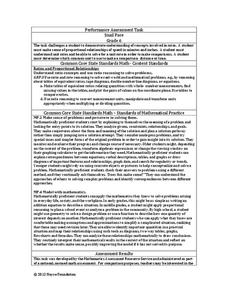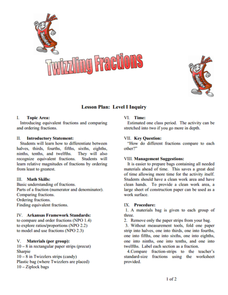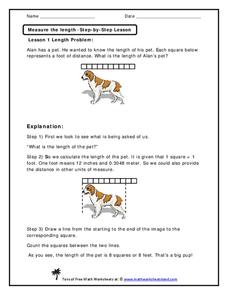Curated OER
Fall Apple Unit
1. practice numeral recognition 1- 10 2. practice counting a set of concrete objects and match it to the corresponding numeral 3. identify a digital camera and learn to take a picture;The students will: 1. Listen to the book, "Ten Apples...
Noyce Foundation
Snail Pace
Slow and steady wins the race? In the assessment task, scholars calculate the rates at which different snails travel in order to find the fastest snail. Hopefully, your class will move much more quickly in finishing the task!
Curated OER
Searching for Angles and Lines
Young scholars work to find and reinforce concepts related to lines and angles. They identify the characteristics of shapes that have one, two, and three dimensions. The students also work on definitions related to the geometry of shapes.
Curated OER
Quiz: Angles with Parallel Lines
Middle schoolers identify all pairs of angles formed from parallel lines and a transversal. They use the definitions of alternate interior, alternate exterior and corresponding angles to determine the value of given angles. This one-page...
Curated OER
Addition Practice
Give your mathematicians a leg up on simple addition using this activity with visual aids. Similar to counting cubes, each single-digit addend is accompanied by a corresponding number of colored squares. The two colors are joined where...
Curated OER
Gummy Candy Count
Use the book, The Gummy Candy Counting Book, to practice counting up to ten objects in a group. This lesson nicely-combines language arts and math in a way that should lead to effective teaching.
University of Arkansas
Twizzling Fractions
Using food as a manipulative is one of the best ways to incorporate hands-on learning in the classroom. This hands-on approach allows young mathematicians to compare, order, and identify fractions with the use of Twizzlers® and fraction...
Curated OER
Area of the Rectangle Word Problems
Don't let the title fool you; these are visual area problems. Scholars examine five rectangles segmented into rows and columns, matching them to their corresponding area on the right. There are no units involved here as this is for...
Curated OER
The Distributive Property
MIddle schoolers use the distributive property to combine terms in six expressions. They write nine expressions in simplest form. Young scholars perform one mental math problem, describing how they would solve the multiplication mentally.
Illustrative Mathematics
How Many Solutions?
Determining the number of solutions is an important stepping stone to higher math. In this case, the resource asks algebra pupils to find a second linear equation for a certain solution of a system. When one is asked for a linear...
Curated OER
Frequency Distributions
In this statistics worksheet, students solve 5 frequency problems. In four of the problems, the frequency table is provided and students construct one relative frequency table, one cumulative frequency table, and two cumulative relative...
Curated OER
Favorite Apple Graph
First graders record their favorite type of apple in the form of a graph. They each try one slice of a Red Delicious, Golden Delicious, and Granny Smith apple, select their favorite type, and create a class graph using the data collected.
Teachers.net
Solving Equations Using Variables
Middle-schoolers solve linear equations with one single variable. They solve equations that are randomly generated using index cards. Half of an equation is written on each card and distributed to the class. which then attempts solve...
Curated OER
Measure the Length
Practice measurements with your scholars using this word problem. Because the answer is explained at the bottom of the page, this would work best as an all-class warm up. Cover up the answers until after kids have shared responses. They...
Curated OER
Play I Spy
Pre-readers examine a rainy-day picture with many details to find words beginning with either p, u, w, or l. They tally the number of objects they find and write the numbers beside each letter. To help kids stay organized and meet...
Math Mammoth
Polygons
In this polygon activity, students identify similar polygons and corresponding sides. They use a compass and ruler to construct polygons, determine the sum of the angles in a given polygon. There are 4 multi-step problems in this...
Curated OER
Using Tables to Solve Linear Functions
Oh that intercept! Budding algebra masters solve linear equations from standard to intercept form. They identify the slope and y-intercept to help graph the lines, an then create coordinate pairs using a table of values. Great TI tips...
Curated OER
Z-Scores related to Psychology
For this z-score worksheet, students identify the z-scores and percentiles corresponding to thirteen values. Students are also asked to find two probabilities. Worked solutions are provided after each question.
Curated OER
Introduction to Trigonometry
Students identify the six trigonometric ratios and properties. In this trig lesson plan, students define basic trig functions as it relates to solving right triangles. They identify the equation for sine as o/h and cosine as a/h and...
Curated OER
Party Math
Young scholars create a spreadsheet that they will use to plan a small party or outing. They calculate expenses and stay within a budget amount for their party.
Curated OER
Watermelon Count
In this counting to ten worksheet, students count the numbers of seeds on the watermelons and match them with the corresponding numbers written in the squares. Students solve 10 problems;
Curated OER
Candy Cane Count
In this counting to ten worksheet, learners count the numbers of stripes on the candy canes and match them with the corresponding numbers written in the squares. Students solve 10 problems.
Curated OER
Sunflower Count
In this counting to ten worksheet, students count the numbers of seeds on the sunflowers and match them with the corresponding numbers written in the squares. Students solve 10 problems.
Curated OER
Fractions: Mud Pie Math
Second graders identify and name fractional parts through the use of mud pie manipulatives. In this fractional manipulatives lesson, 2nd graders identify and label halves, thirds, fourths, sixths, eighths, and tenths and order them...

























